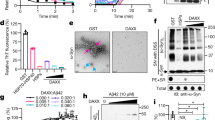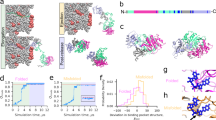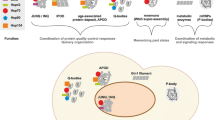Abstract
Under normal growth conditions, tumor-suppressor proteins and oncogenes play key roles in the tight regulation of cell division (1). Tumorigenesis often arises from mutations that interfere with the appropriate function of these regulatory proteins. Tumor-causing mutations may result in either an alteration of the catalytic activity of the protein, loss of a binding site for a partner or effector protein, or an alteration of the native folded conformation. There are a growing number of examples in which protein misfolding is associated with tumorigenesis. In some cases, misfolded tumor supressors are simply inactive and lead to cancer as a result of a loss-of-function phenotype, as in the case of tumor-suppressor proteins VHL and NF2. Alternatively, the mutated proteins may adopt an aberrant conformation that is regulated differently than the wild-type protein. Such mutations may lead to a dominant-negative inactivation of the wild-type tumor suppressor, as in the case of p53 and WT1, or to constitutive activation of an oncogenic protein, as in the case of the Src family kinases. Here we review a number of examples that illustrate how alterations in the folding of tumor-suppressor proteins or oncogenes lead to carcinogenesis. Most of the cases also involve altered interactions of these proteins with the components of the cellular folding machinery. Eukaryotic molecular chaperones such as TRiC/CCT, Hsp70, and Hsp90 play important roles in both assisting protein folding and in quality-control processes that recognize and target misfolded proteins for degradation by the Ubiquitin-26S Proteasome pathway (2,3).
Access this chapter
Tax calculation will be finalised at checkout
Purchases are for personal use only
Similar content being viewed by others
References
Cooper, G. M. (1995) Oncogenes, 2nd ed. Jones and Bartlett Publishers, London.
Frydman, J. (2001) Folding of newly translated proteins in vivo: the role of molecular chaperones. Annu. Rev. Biochem. 70, 603–647.
Glickman, M. H., and Ciechanover, A. (2002) The ubiquitin-proteasome proteolytic pathway: destruction for the sake of construction. Physiol. Rev. 82, 373–428.
Vogelstein, B., Lane, D., and Levine, A. J. (2000) Surfing the p53 network. Nature 408, 307–310.
Kubbutat, M. H., Jones, S. N., and Vousden, K. H. (1997) Regulation of p53 stability by Mdm2. Nature 387, 299–303.
Miyashita, T., Krajewski, S., Krajewska, M., Wang, H. G., Lin, H. K., Liebermann, D. A., et al. (1994) Tumor suppressor p53 is a regulatory of bcl-2 and bax gene expression in vitro and in vivo. Oncogene 9, 1799–1805.
Evans, S. C. and Lozano, G. (1997) The Li-Fraumeni syndrome: an inherited susceptibility to cancer. Mol. Med. Today 3, 390–395.
Friedman, P. N., Chen, X., Bargonetti, J., and Prives, C. (1993) The p53 protein is an unusually shaped tetramer that binds directly to DNA. Proc. Natl. Acad. Sci. USA 90, 3319–3323.
Fourie, A. M., Hupp, T. R., Lane, D. P., Sang, B. C., Barbosa, M. S., Sambrook, J. F., and Gething, M. J. (1997) HSP70 binding sites in the tumor suppressor protein p53. J. Biol. Chem. 272, 19,471–19,479.
Cho, Y., Gorina, S., Jeffrey, P. D., and Pavletich, N. P. (1994) Crystal structure of a p53 tumor suppressor-DNA complex: understanding tumorigenic mutations. Science 265, 346–355.
Jeffrey, P. D., Gorina, S., and Pavletich, N. P. (1995) Crystal structure of the tetramerization domain of the p53 tumor suppressor at 1.7 angstroms. Science 267, 1498–1502.
Gorina, S. and Pavletich, N. P. (1996) Structure of the p53 tumor suppressor bound to the ankyrin and SH3 domains of 53BP2. Science 274, 1001–1005.
Kussie, P. H., Gorina, S., Marechal, V., Elenbaas, B., Moreau, J., Levine, A. J., and Pavletich, N. P. (1996) Structure of the MDM2 oncoprotein bound to the p53 tumor suppressor transactivation domain. Science 274, 948–953.
Zylicz, M., King, F. W., and Wawrzynow, A. (2001) Hsp70 interactions with the p53 tumour suppressor protein. EMBO J. 20, 4634–4638.
Whitesell, L., Sutphin, P., An, W. G., Schulte, T., Blagosklonny, M. V., and Neckers, L. (1997) Geldanamycin-stimulated destabilization of mutated p53 is mediated by the proteasome in vivo. Oncogene 14, 2809–2816.
Whitesell, L., Sutphin, P. D., Pulcini, E. J., Martinez, J. D., and Cook, P. H. (1998) The physical association of multiple molecular chaperone proteins with mutant p53 is altered by geldanamycin, an hsp90-binding agent. Mol. Cell. Biol. 18, 1517–1524.
King, F. W., Wawrzynow, A., Hohfeld, J., and Zylicz, M. (2001) Co-chaperones Bag-1, Hop and Hsp40 regulate Hsc70 and Hsp90 interactions with wild-type or mutant p53. EMBO J. 20, 6297–6305.
Peng, Y., Chen, L., Li, C., Lu, W., and Chen, J. (2001) Inhibition of MDM2 by hsp90 contributes to mutant p53 stabilization. J. Biol. Chem. 276, 40,583–40,590.
Hainaut, P. and Milner, J. (1992) Interaction of heat-shock protein 70 with p53 translated in vitro: evidence for interaction with dimeric p53 and for a role in the regulation of p53 conformation. EMBO J. 11, 3513–3520.
Akakura, S., Yoshida, M., Yoneda, Y., and Horinouchi, S. (2001) A role for Hsc70 in regulating nucleocytoplasmic transport of a temperature-sensitive p53 (p53Val-135). J. Biol. Chem. 276, 14,649–14,657.
Hollstein, M., Sidransky, D., Vogelstein, B., and Harris, C. C. (1991) p53 mutations in human cancers. Science 253, 49–53.
Milner, J., Medcalf, E. A., and Cook, A. C. (1991) Tumor suppressor p53: analysis of wild-type and mutant p53 complexes. Mol. Cell. Biol. 11, 12–19.
Milner, J. and Medcalf, E. A. (1991) Cotranslation of activated mutant p53 with wild type drives the wild-type p53 protein into the mutant conformation. Cell 65, 765–774.
Blagosklonny, M. V., Toretsky, J., Bohen, S., and Neckers, L. (1996) Mutant conformation of p53 translated in vitro or in vivo requires functional HSP90. Proc. Natl. Acad. Sci. USA 93, 8379–8383.
Blagosklonny, M. V. (2002) p53: an ubiquitous target of anticancer drugs. Int. J. Cancer 98, 161–166.
Scharnhorst, V., van der Eb, A. J., and Jochemsen, A. G. (2001) WT1 proteins: functions in growth and differentiation. Gene 273, 141–161.
Dome, J. S., and Coppes, M. J. (2002) Recent advances in Wilms tumor genetics. Curr. Opin. Pediatr. 14, 5–11.
Lee, S. B. and Haber, D. A. (2001) Wilms tumor and the WT1 gene. Exp. Cell. Res. 264, 74–99.
Larsson, S. H., Charlieu, J. P., Miyagawa, K., Engelkamp, D., Rassoulzadegan, M., Ross, A., et al. (1995) Subnuclear localization of WT1 in splicing or transcription factor domains is regulated by alternative splicing. Cell 81, 391–401.
Maheswaran, S., Englert, C., Zheng, G., Lee, S. B., Wong, J., Harkin, D. P., et al. (1998) Inhibition of cellular proliferation by the Wilms tumor suppressor WT1 requires association with the inducible chaperone Hsp70. Genes Dev. 12, 1108–1120.
Haber, D. A., Timmers, H. T., Pelletier, J., Sharp, P. A., and Housman, D. E. (1992) A dominant mutation in the Wilms tumor gene WT1 cooperates with the viral oncogene E1A in transformation of primary kidney cells. Proc. Natl. Acad. Sci. USA 89, 6010–6014.
Ivan, M. and Kaelin, W. G., Jr. (2001) The von Hippel-Lindau tumor suppressor protein. Curr. Opin. Genet. Dev. 11, 27–34.
Duan, D. R., Pause, A., Burgess, W. H., Aso, T., Chen, D. Y., Garrett, K. P., et al. (1995) Inhibition of transcription elongation by the VHL tumor suppressor protein. Science 269, 1402–1406.
Lonergan, K. M., Iliopoulos, O., Ohh, M., Kamura, T., Conaway, R. C., Conaway, J. W., and Kaelin, W. G., Jr. (1998) Regulation of hypoxia-inducible mRNAs by the von Hippel-Lindau tumor suppressor protein requires binding to complexes containing elongins B/C and Cul2. Mol. Cell. Biol. 18, 732–741.
Maxwell, P. H., Wiesener, M. S., Chang, G. W., Clifford, S. C., Vaux, E. C., Cockman, M. E., et al. (1999) The tumour suppressor protein VHL targets hypoxia-inducible factors for oxygen-dependent proteolysis. Nature 399, 271–275.
Tanimoto, K., Makino, Y., Pereira, T., and Poellinger, L. (2000) Mechanism of regulation of the hypoxia-inducible factor-1 alpha by the von Hippel-Lindau tumor suppressor protein. EMBO J. 19, 4298–4309.
Clifford, S. C., Cockman, M. E., Smallwood, A. C., Mole, D. R., Woodward, E. R., Maxwell, P. H., et al. (2001) Contrasting effects on HIF-1alpha regulation by disease-causing pVHL mutations correlate with patterns of tumourigenesis in von Hippel-Lindau disease. Hum. Mol. Genet. 10, 1029–1038.
Kibel, A., Iliopoulos, O., DeCaprio, J. A., and Kaelin, W. G., Jr. (1995) Binding of the von Hippel-Lindau tumor suppressor protein to Elongin B and C. Science 269, 1444–1446.
Stebbins, C. E., Kaelin, W. G., Jr., and Pavletich, N. P. (1999) Structure of the VHL-ElonginC-ElonginB complex: implications for VHL tumor suppressor function. Science 284, 455–461.
Feldman, D. E., Thulasiraman, V., Ferreyra, R. G., and Frydman, J. (1999) Formation of the VHL-elongin BC tumor suppressor complex is mediated by the chaperonin TRiC/CCT. Mol. Cell 4, 1051–1061.
Reed, N. and Gutmann, D. H. (2001) Tumorigenesis in neurofibromatosis: new insights and potential therapies. Trends Mol. Med. 7, 157–162.
Bashour, A. M., Meng, J. J., Ip, W., MacCollin, M., and Ratner, N. (2002) The neurofibromatosis type 2 gene product, merlin, reverses the F-actin cytoskeletal defects in primary human Schwannoma cells. Mol. Cell. Biol. 22, 1150–1157.
Gutmann, D. H., Hirbe, A. C., and Haipek, C. A. (2001) Functional analysis of neurofibromatosis 2 (NF2) missense mutations. Hum. Mol. Genet. 10, 1519–1529.
Brault, E., Gautreau, A., Lamarine, M., Callebaut, I., Thomas, G., and Goutebroze, L. (2001) Normal membrane localization and actin association of the NF2 tumor suppressor protein are dependent on folding of its N-terminal domain. J. Cell Sci. 114, 1901–1912.
Thomas, S. M. and Brugge, J. S. (1997) Cellular functions regulated by Src family kinases. Annu. Rev. Cell. Dev. Biol. 13, 513–609.
Brown, M. T. and Cooper, J. A. (1996) Regulation, substrates and functions of src. Biochim. Biophys. Acta 1287, 121–149.
Irby, R. B. and Yeatman, T. J. (2000) Role of Src expression and activation in human cancer. Oncogene 19, 5636–5642.
Hartson, S. D., Barrett, D. J., Burn, P., and Matts, R. L. (1996) Hsp90-mediated folding of the lymphoid cell kinase p56lck. Biochemistry 35, 13,451–13,459.
Yorgin, P. D., Hartson, S. D., Fellah, A. M., Scroggins, B. T., Huang, W., Katsanis, E., et al. (2000) Effects of geldanamycin, a heat-shock protein 90-binding agent, on T cell function and T cell nonreceptor protein tyrosine kinases. J. Immunol. 164, 2915–2923.
Bijlmakers, M. J. and Marsh, M. (2000) Hsp90 is essential for the synthesis and subsequent membrane association, but not the maintenance, of the Src-kinase p56(lck). Mol. Biol. Cell 11, 1585–1595.
Scholz, G. M., Hartson, S. D., Cartledge, K., Volk, L., Matts, R. L., and Dunn, A. R. (2001) The molecular chaperone Hsp90 is required for signal transduction by wild-type Hck and maintenance of its constitutively active counterpart. Cell Growth Differ. 12, 409–417.
Smith, D. F., Whitesell, L., and Katsanis, E. (1998) Molecular chaperones: biology and prospects for pharmacological intervention. Pharmacol. Rev. 50, 493–514.
Neckers, L. (2002) Hsp90 inhibitors as novel cancer chemotherapeutic agents. Trends Mol. Med. 8, S55–S61.
Zheng, F. F., Kuduk, S. D., Chiosis, G., Munster, P. N., Sepp-Lorenzino, L., Danishefsky, S. J., and Rosen, N. (2000) Identification of a geldanamycin dimer that induces the selective degradation of HER-family tyrosine kinases. Cancer Res. 60, 2090–2094.
Munster, P. N., Srethapakdi, M., Moasser, M. M., and Rosen, N. (2001) Inhibition of heat shock protein 90 function by ansamycins causes the morphological and functional differentiation of breast cancer cells. Cancer Res. 61, 2945–2952.
Author information
Authors and Affiliations
Editor information
Editors and Affiliations
Rights and permissions
Copyright information
© 2003 Humana Press Inc., Totowa, NJ
About this protocol
Cite this protocol
Scott, M.D., Frydman, J. (2003). Aberrant Protein Folding as the Molecular Basis of Cancer. In: Bross, P., Gregersen, N. (eds) Protein Misfolding and Disease. Methods in Molecular Biology™, vol 232. Humana Press. https://doi.org/10.1385/1-59259-394-1:67
Download citation
DOI: https://doi.org/10.1385/1-59259-394-1:67
Publisher Name: Humana Press
Print ISBN: 978-1-58829-065-6
Online ISBN: 978-1-59259-394-1
eBook Packages: Springer Protocols




